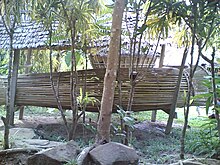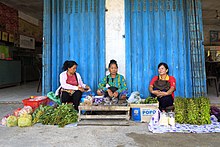
Dusun is the collective name of an indigenous ethnic group to the Malaysian state of Sabah of North Borneo. Collectively, they form the largest ethnic group in Sabah. The Dusun people have been internationally recognised as indigenous to Borneo since 2004 as per the United Nations Educational, Scientific and Cultural Organization (UNESCO).

Kudat is the capital of the Kudat District in the Kudat Division of Sabah, Malaysia. Its population was estimated to be around 29,025 in 2010. It is located on the Kudat Peninsula, about 190 kilometres (120 mi) north of Kota Kinabalu, the state capital, and is near the northernmost point of Borneo. It is the largest town in the heartland of the Rungus people which is a sub-ethnic group of the majority Kadazan-Dusun race and is therefore a major centre of Rungus culture. It is also notable for being one of the first parts of Sabah to be settled by Chinese Malaysians, particularly from the Hakka dialect group. It is the Northernmost Malaysian city.

The Kadazans are an ethnic group indigenous to the state of Sabah in Malaysia. They are found mainly in Penampang on the west coast of Sabah, the surrounding locales, and various locations in the interior.

The Murut, alternatively referred to as Tagol/Tahol, constitute an indigenous ethnic community comprising 29 distinct sub-ethnic groups dwelling within the northern inland territories of Borneo. Characterized by their rich cultural diversity, the Murutic languages form a linguistic family encompassing approximately half a dozen closely intertwined Austronesian languages. Murut populations exhibit dispersion in Malaysia's Sabah and the northern part of Sarawak, as well as in the country of Brunei and the Indonesian North Kalimantan Province. Furthermore, the Murut people have close connections with the Tidung, who historically inhabited Borneo's east coast region that underwent processes of Islamization and Malayalization,

Kadazan-Dusun are the largest ethnic group in Sabah, Malaysia, an amalgamation of the closely related indigenous Kadazan and Dusun peoples. They are also known as Mamasok Sabah, meaning "indigenous people of Sabah". Kadazan-Dusun tradition holds that they are the descendants of Nunuk Ragang. Kadazan-Dusun is recognised as an indigenous nation of Borneo with documented heritage by the United Nations Educational, Scientific and Cultural Organization (UNESCO) since 2004. Kadazan-Dusun is part of bumiputera group in Malaysia and has special rights concerning land, rivers, education and maintaining their own customs.
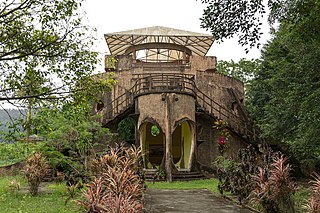
Nunuk Ragang is a site traditionally considered as the location of the original home of the ancestors of the Kadazan-Dusun natives who inhabit most of northern Borneo. The site, nearby a village named Tampias, is located at the intersection of the left and right branches of the Liwagu River to the east of Ranau and Tambunan in Sabah. The two river branches joined up to flow into the Labuk river and drain out into the Sulu Sea. At the site, and under a giant banyan tree, a settlement referred to as Nunuk Ragang was founded. The giant banyan tree was said to be able to give shade to a longhouse sheltering 10 families in it. The legend about Nunuk Ragang had been passed down via oral traditions to the younger generations. No archaeological dig has been carried out to establish the veracity of the legend.
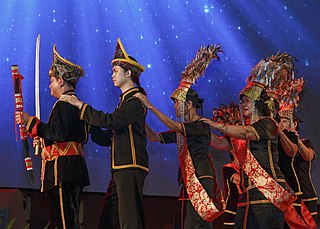
Kaamatan or Pesta Kaamatan is a form of harvest festival celebrated on 30 and 31 of May annually in the state of Sabah and Federal Territory of Labuan in Malaysia. It is normally celebrated by the ethnic Kadazan-Dusuns, as well as by other related ethnic groups in the state, and lasts for the whole of the month of May, ending with a public holiday on a date selected by a priestess known as the bobohizan.

Pakaian is the term for clothing in Malaysia's national language. It is referring to things to wear such as shirts, pants, shoes etc. Since Malaysia is a multicultural nation: Malay, Chinese, Indian and hundreds of other indigenous groups of Malay Peninsula and Borneo, each has its own traditional and religious articles of clothing all of which are gender-specific and may be adapted to local influences and conditions. Previously, traditional clothes were worn daily. However, by excluding Baju Melayu, Baju Kurung many are now only worn on special occasions such as marriage ceremonies and cultural events.

Malaysian folk religion refers to the animistic and polytheistic beliefs and practices that are still held by many in the Islamic-majority country of Malaysia. Folk religion in Malaysia is practised either openly or covertly depending on the type of rituals performed.

Datu Mustapha bin Datu Harun, or Tun Mustapha for short, was a Malaysian politician who served as the 3rd Chief Minister of Sabah from May 1967 to November 1975 and the 1st Yang Di-Pertua Negara from September 1963 to September 1965 and President of the United Sabah National Organisation (USNO). He was an important party in the negotiations leading to the formation of Malaysia on 16 September 1963.

Datuk Seri Panglima Md Salleh bin Md Said, commonly known as Salleh Said Keruak, is a Malaysian politician who has served as Member of the Sabah State Legislative Assembly for Usukan from February 1994 to March 2004, from May 2013 to May 2018 and again since September 2020. He served as the Minister of Communications and Multimedia in the Barisan Nasional (BN) administration under former Prime Minister Najib Razak from July 2015 to the collapse of the BN administration in May 2018, 9th chief minister of Sabah from December 1994 to May 1996, Speaker of the Sabah State Legislative Assembly from December 2010 to July 2015, Senator from July 2015 to July 2018 and Member of Parliament (MP) for Kota Belud from April 1995 to March 2008. He is also the son of Mohammad Said Keruak, the 4th chief minister of Sabah and the 7th Yang di-Pertua Negeri of Sabah as well as the cousin of Isnaraissah Munirah Majilis, the Kota Belud MP.

Sedomon Gunsanad Kina MBE (1894-1966) was a native chief of Keningau, in North Borneo, who later became a politician in unified Malaysia. He was the son of Gunsanad Kina and the older brother of G.S Sundang.

The sumazau is a dance performed by the Kadazandusun from Penampang and adjacent areas in west coast Sabah. It is usually performed during Kaamatan. The dance involves male and female pairs who are dressed in traditional clothing. The rhythm of the dance is set by the beat of hanging gongs. It is performed by raising both arms to shoulder height and flapping them.
Tun Mohd Hamdan bin Abdullah was the fourth Governor of the Malaysian state of Sabah.

Sabahan cuisine is a regional cuisine of Malaysia. As in the rest of Malaysian cuisine, Sabah food is based on staples such as rice with a great variety of other ingredients and different methods of food preparations due to the influence of the state's varied geography and indigenous cultures that were quite distinct from the regional cuisines of the Peninsular Malaysia. Sabah along with its neighbour of Sarawak is famous for their multi-ethnic population.

Sabah is the third most populous state in Malaysia, with a population of 3,418,785 according to the 2020 Malaysian census. It also has the highest non-citizen population, at 810,443. Although Malaysia is one of the least densely populated countries in Asia, Sabah is particularly sparsely populated. Most of the population is concentrated along coastal areas, with towns and urban centers seeing the most population growth.

The Kudat District is an administrative district in the Malaysian state of Sabah, part of the Kudat Division which includes the districts of Kota Marudu, Kudat and Pitas. The capital of the district is in Kudat Town.
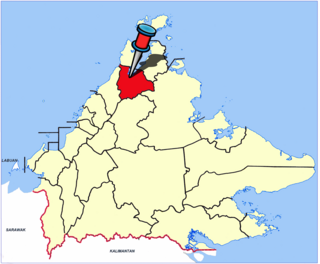
The Kota Marudu District is an administrative district in the Malaysian state of Sabah, part of the Kudat Division which includes the districts of Kota Marudu, Kudat and Pitas. The capital of the district is in Kota Marudu Town.
Datuk Jonathan bin Yasin is a Malaysian politician who has served as the Member of Parliament (MP) for Ranau since May 2018. He served as the Deputy Minister of Home Affairs II for the second term in the Barisan Nasional (BN) administration under former Prime Minister Ismail Sabri Yaakob and former Minister Hamzah Zainuddin from August 2021 to the collapse of the BN administration in November 2022 and the first term in Perikatan Nasional (PN) administration under former Prime Minister Muhyiddin Yassin and former Minister Hamzah from March 2020 to the collapse of the PN administration in August 2021. He is a direct member of the Gabungan Rakyat Sabah (GRS) coalition. He joined the Malaysian United Indigenous Party (BERSATU), a component party of the PN coalition after resigning from the People's Justice Party (PKR), a component party of the Pakatan Harapan (PH) opposition coalition. He later resigned from BERSATU but remained in GRS as direct member.

Traditional Malaysian art is primarily composed of Malay art and Bornean art, is very similar with the other styles from Southeast Asia, such as Bruneian, Indonesian and Singaporean. Art has a long tradition in Malaysia, with Malay art that dating back to the Malay sultanates, has always been influenced by Chinese, Indian and Islamic arts, and also present, due to large population of Chinese and Indian in today's Malaysian demographics.

